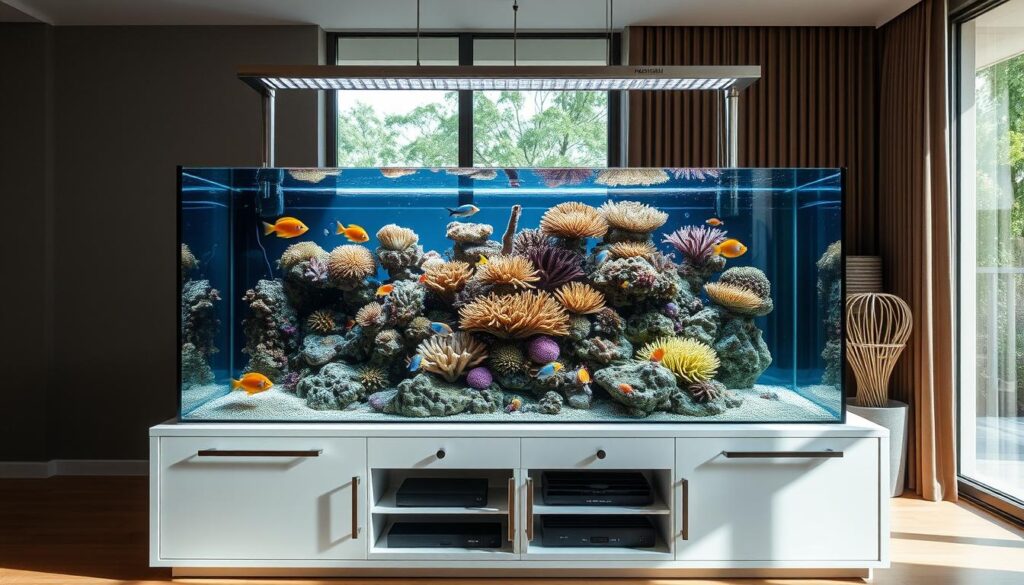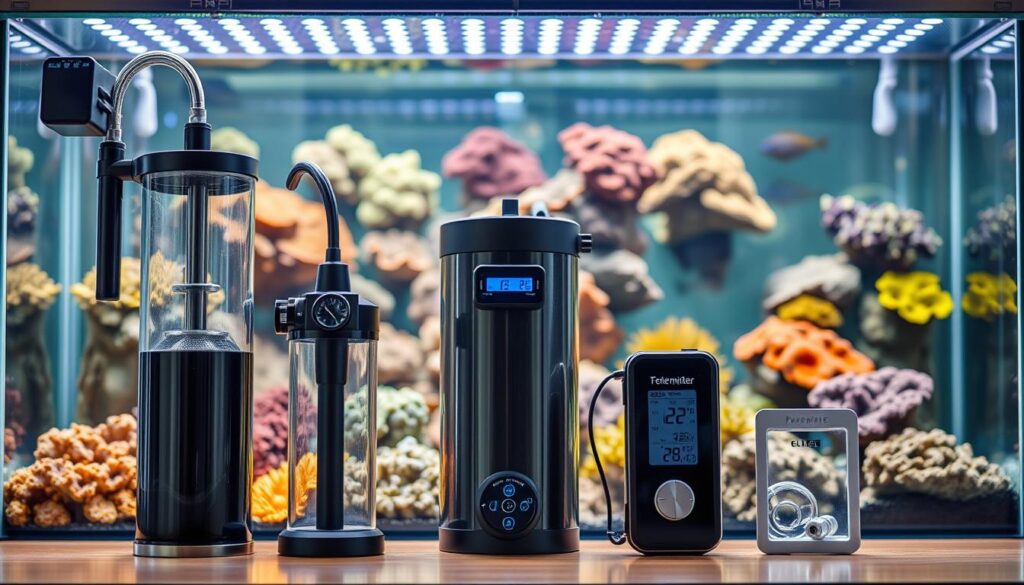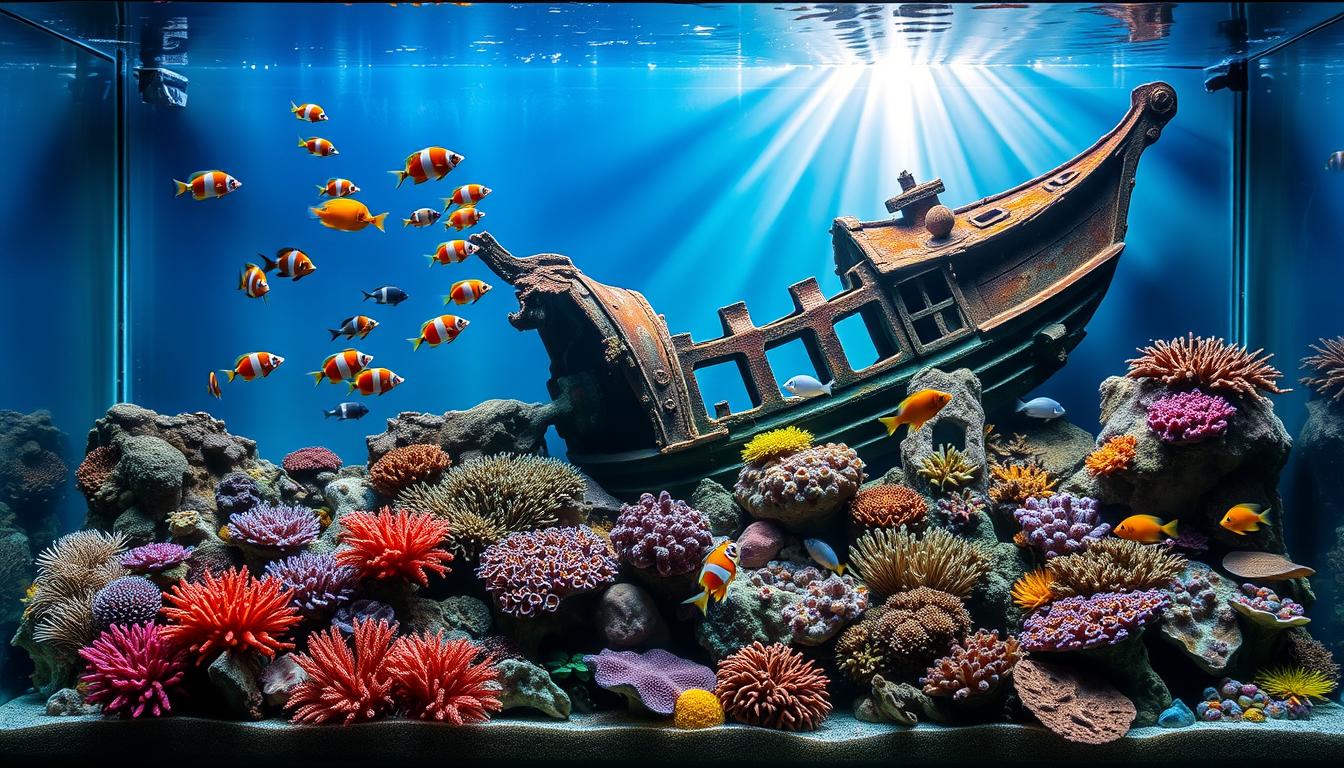Did you know a well-maintained large saltwater fish tank can be calming and mesmerizing? It’s a great addition to any home or office.
Building a saltwater aquarium is easier than ever. With the right equipment and good information, you can set up your tank quickly!
We’re excited to help you set up and maintain a thriving saltwater aquarium. Whether you’re new or experienced, we’ll cover the benefits of a larger tank. We’ll also help you solve common problems.
Key Takeaways
- Learn how to set up a stable and healthy saltwater environment
- Discover the benefits of a larger saltwater tank
- Understand how to choose the right equipment for your aquarium
- Get tips on maintaining a thriving saltwater ecosystem
- Troubleshoot common issues that may arise in your saltwater aquarium
The Benefits of a 100 Gallon Saltwater Aquarium
Setting up a 100-gallon saltwater aquarium is a big step. It can change your aquarium-keeping experience for the better. A larger tank brings many benefits that make caring for your aquarium more fun and rewarding.
Why Size Matters in Marine Aquariums
A bigger aquarium means a more stable home for your marine life. A 100-gallon tank gives your fish and corals plenty of space. This space helps keep the water stable, which is key for their health.
Stability and Water Parameter Benefits
The extra water in a 100-gallon tank helps keep the water clean and balanced. This means less stress for your marine life. You get to enjoy your underwater world more!
Expanded Stocking Options
A bigger tank lets you stock it with more variety. You can have a wide range of fish and invertebrates. This makes your aquarium lively and interesting. Plus, you have more choices for compatible saltwater fish.
Choosing a 100-gallon saltwater aquarium is more than just setting up a tank. It’s about creating a thriving marine world. This world can bring joy and wonder into your life.
Planning Your Marine Tank Investment
Starting a thriving marine ecosystem begins with a well-thought-out investment in your tank. When setting up your 100-gallon saltwater aquarium, several key factors need careful consideration.
Selecting the Right Location
Finding the perfect spot for your aquarium is more than looks; it’s about function and safety. You must think about the tank’s weight when full and how easy it is to maintain.
Weight Considerations
A 100-gallon tank, filled with water, gravel, and marine life, can weigh over 1,000 pounds! Make sure the floor can handle this weight and that your home’s structure is strong enough.
Access for Maintenance
Regular maintenance, like water changes and equipment checks, is essential. Pick a location that makes it easy to access the tank.

Tank Dimensions and Stand Requirements
Knowing your tank’s dimensions and choosing the right stand is critical. The stand must be sturdy and support the tank’s weight.
Budget Considerations
Investing in a 100-gallon saltwater aquarium is more than the initial cost. You must also budget for ongoing expenses, such as equipment, marine life, and maintenance supplies.
Initial Setup Costs
The initial setup includes buying the tank, stand, equipment (like filters, heaters, and lighting), and the first batch of marine life and supplies.
Ongoing Maintenance Expenses
Regular costs include parts for equipment, food for your marine life, and supplies for water changes.
By planning your marine tank investment carefully, you’re on your way to a thriving marine ecosystem. It will bring joy and wonder into your life.
Essential Equipment for Your 100 Gallon Saltwater Aquarium
To make a stunning and healthy marine environment, you need the right equipment for your 100-gallon saltwater aquarium. The right gear not only makes your tank look great but also keeps your marine life healthy.
Filtration Systems
A good filtration system is key to a successful saltwater aquarium. It keeps the water clean by removing waste and extra nutrients.
Mechanical Filtration Options
Mechanical filtration catches particles from the water. High-quality filter pads or cartridges are great for this. They stop debris from going back into the tank.
Biological Filtration Methods
Biological filtration is important for breaking down harmful substances. This happens in bio-media or live rock, where good bacteria live.
| Filtration Type | Function | Examples |
|---|---|---|
| Mechanical | Removes physical particles | Filter pads, cartridges |
| Biological | Breaks down ammonia and nitrite | Bio-media, live rock |
Protein Skimmers
Protein skimmers are essential for keeping the water clean. They remove organic compounds, improving water quality and reducing algae. Choose a skimmer based on your tank’s size and the marine life you have.

Lighting Options
Lighting is not just for looks; it also helps corals and other marine life grow. You can choose from LED, T5, and metal halide lighting, depending on your tank’s needs and the marine life you keep.
LED vs. T5 vs. Metal Halide
- LED Lighting: LEDs are energy-efficient and customizable, making them popular for reef tanks.
- T5 Lighting: T5 lights have a broad spectrum and are very intense.
- Metal Halide: Metal halides are high-intensity and often used in deep tanks or for growing corals.
Circulation and Powerheads
Good water circulation is key for a healthy tank. It simulates ocean currents and makes sure all parts of the tank get enough water flow. Powerheads help by creating adjustable water movement.
Heating and Cooling Solutions
Keeping the water temperature stable is vital for your marine life’s health. Heaters and cooling systems or chillers help keep the water at the right temperature for your tank’s inhabitants.
By choosing and maintaining the right equipment, you’ll create a thriving 100-gallon saltwater aquarium. It will bring joy and wonder to your life.
Setting Up Your 100 Gallon Saltwater Aquarium
Setting up a 100-gallon saltwater aquarium is exciting. It’s the first step to creating a thriving marine world. This process involves several key steps to ensure a healthy and vibrant aquarium.
Aquascaping with Live Rock
Live rock is essential for your aquarium’s ecosystem. It provides biological filtration and a natural home for marine life. When using live rock, it’s important to create stable structures. These structures should not topple over or harm the aquarium or its inhabitants.
Creating Stable Structures
To start, place the largest and heaviest rocks at the bottom. This creates a solid base for your structure. Use a mix of rocks to build caves, overhangs, and crevices. These will provide hiding spots for fish and a home for beneficial organisms.
Designing for Fish and Coral Needs
When designing your aquascape, think about the needs of your fish and corals. Some fish need open swimming space, while others prefer hiding spots. Corals require good lighting and water flow. By balancing these needs, you can create a thriving ecosystem.
Substrate Selection and Depth
The substrate you choose is important for your aquarium’s health and look. A deep sand bed is good for some species but needs careful consideration to avoid anaerobic pockets.
Choosing the right substrate involves looking at grain size, color, and composition. A substrate that’s too fine can cause cloudiness. One that’s too coarse may not support beneficial bacteria well.
Water Preparation and Parameters
Preparing the water for your saltwater aquarium is critical. You need to make it as close to natural seawater as possible.
Mixing Salt Solutions
To mix your saltwater, use a high-quality marine aquarium salt mix. Follow the instructions to get the right salinity, usually measured in specific gravity or parts per thousand (ppt).
Target Parameters for Reef Systems
For a reef system, you need to keep specific water parameters. These include a pH of 8.1 to 8.4, alkalinity of 8 to 12 dKH, and calcium levels around 400 ppm. Regular testing and adjustments are needed to keep these parameters stable.
| Parameter | Ideal Range |
|---|---|
| pH | 8.1 – 8.4 |
| Alkalinity (dKH) | 8 – 12 |
| Calcium (ppm) | around 400 |
| Salinity (ppt) | 1.020 – 1.025 |
The Cycling Process: Establishing Biological Filtration
Starting a saltwater aquarium means learning about the cycling process. This step is key to a healthy home for your marine life. But what is cycling, and why is it so vital?
Understanding the Cycling
Cycling is about growing beneficial bacteria in your tank’s filter. These bacteria turn harmful waste into safe nitrate. Jeffrey N. Jorgensen, a famous aquarist, said, “A well-cycled tank is the heart of a healthy aquarium.”
“A well-cycled tank is the backbone of a healthy aquarium ecosystem.” – Jeffrey N. Jorgensen
Cycling Methods for Large Tanks
For a 100-gallon saltwater tank, you have a few cycling methods. Let’s look at two good ones:
Fishless Cycling Techniques
Fishless cycling adds ammonia to feed the bacteria. You can use raw fish, shrimp, or ammonia supplements. It takes 4-6 weeks and is kinder to fish.
Using Bacterial Starters
Bacterial starters have live bacteria to quickly fill your tank. They cut down cycling time and are perfect for fast stocking.
Monitoring Water Parameters During Cycling
Keep a close eye on your tank’s water during cycling. Test for ammonia, nitrite, and nitrate often. You’ll see ammonia spike, then nitrite, and lastly nitrate rise. This means your tank is cycling well!

Learning and following the cycling process well sets you up for a thriving marine world. Remember, patience is essential. Rushing can cause problems later!
Selecting Compatible Marine Life
Choosing the right marine life for your 100-gallon saltwater aquarium is key. You want a peaceful underwater world, not a fight zone. Let’s look at how to pick the best fish and invertebrates for your tank.
Fish Selection and Compatibility
Picking the right fish for your 100-gallon saltwater aquarium is both an art and a science. You must think about size, temperament, and what they eat. Here are some tips to help you:
Peaceful Community Species
For a calm community, think about species like Chrysiptera damsels, Centropyge angelfish (dwarf angels), and peaceful wrasses. These fish are usually easy-going and can live with many others.
Semi-Aggressive Options
If you want semi-aggressive fish, consider Anthias, larger wrasses, or some triggerfish. But, be careful and check if they get along with your current fish to avoid fights.
Invertebrate Options
Invertebrates can make your aquarium even more interesting. They come in many shapes, sizes, and colors, and are just as fascinating as fish.
Cleanup Crew Selection
A good cleanup crew is vital for a clean and healthy aquarium. Add species like sea cucumbers, starfish, and snails. They help keep your tank clean by controlling algae and detritus.
Ornamental Invertebrates
For beauty, add ornamental invertebrates like corals, anemones, and shrimp. They add color and can form good relationships with other tank inhabitants.

Stocking Timeline and Quarantine Procedures
Stock your aquarium slowly to avoid stressing it. Start with hardy species and then add more sensitive ones. Quarantine new fish before adding them to your main tank to prevent diseases.
| Stocking Phase | Recommended Species | Timeline |
|---|---|---|
| Initial Stocking | Hardy fish like damsels, clownfish | Week 1-2 |
| Secondary Stocking | Semi-aggressive fish, invertebrates | Week 4-6 |
| Final Stocking | Delicate species, corals | Week 8-12 |
By following these guidelines and being patient, you can create a vibrant and peaceful 100-gallon saltwater aquarium. It will showcase a wide variety of marine life.
Live Coral Care in a 100 Gallon System
Live corals can turn your 100-gallon aquarium into a colorful, lively world. Learning the basics of coral care is key to creating a beautiful reef.
Coral Placement and Compatibility
Choosing the right coral spots is important. Some corals can be aggressive, using tentacles or chemicals to fight for space. Aggression and Chemical Warfare are key when picking corals that will live together well.
Aggression and Chemical Warfare
Corals like Galaxea and Euphyllia are quite aggressive. Knowing how different corals behave helps you set up a peaceful reef.
Lighting Requirements for Different Coral Types
Lighting is vital for coral health. Each coral type needs different light levels. For example, SPS (Small Polyp Stony) corals need lots of light, while Soft Corals do better with less.
SPS, LPS, and Soft Coral Needs
Here’s a quick guide to lighting needs for various corals:
| Coral Type | Lighting Needs |
|---|---|
| SPS | High Intensity |
| LPS | Moderate to High |
| Soft Corals | Low to Moderate |
Feeding and Supplementation
Corals need the right food to grow well. This includes Calcium, Alkalinity, and Magnesium supplements, plus Trace Elements for a balanced system.
Calcium, Alkalinity, and Magnesium
These elements are essential for coral growth and color. Keeping them balanced through regular checks and supplements is important.
Trace Elements
Elements like Iodine and Iron are vital for coral health. Adding these can improve coral color and health.
By following these care tips, you’ll be on your way to a thriving coral reef in your 100-gallon tank.
Maintenance Schedule for Large Saltwater Aquariums
Keeping a 100-gallon saltwater aquarium healthy requires regular maintenance. We’ll guide you through the daily, weekly, and monthly tasks needed. This ensures your marine ecosystem stays vibrant.
Daily, Weekly, and Monthly Tasks
Daily, check the water temperature and watch your fish and invertebrates. Also, make sure all equipment is working right. Weekly, test the water and clean the tank glass. Monthly, do a deep clean and check the biological filters.
- Daily: Check water temperature, observe marine life, and ensure equipment is functioning.
- Weekly: Test water parameters, clean tank glass.
- Monthly: Deep clean the tank, inspect biological filtration.
Water Change Protocols
Water changes are key for aquarium health. They remove waste and add nutrients.
Volume Considerations
For a 100-gallon tank, change 10-15% of the water weekly. That’s 10-15 gallons.
Frequency Recommendations
Keep to a weekly water change schedule. It helps keep your aquarium stable.
“Regular water changes are essential for maintaining a healthy aquarium. It’s not just about removing waste; it’s about replenishing what’s lost and keeping parameters stable.”
Equipment Maintenance
Your equipment keeps the water clean and flowing. Regular care ensures it works well.
Cleaning Procedures
Regularly clean protein skimmers, filters, and pumps. This prevents clogs and keeps them efficient.
Replacement Schedules
Some parts, like filter media, need to be replaced often. Check the manufacturer’s guidelines for when.
By sticking to this maintenance schedule, you’ll enjoy a thriving 100-gallon saltwater aquarium. Remember, consistency is key!
Troubleshooting Common Issues in 100 Gallon Reef Tanks
Even with proper care, 100-gallon reef tanks can face problems. But don’t worry, we’ve got you covered! Let’s explore some common issues and their solutions to keep your tank thriving.
Algae Control Strategies
Algae overgrowth is a big problem in reef tanks. First, you need to figure out the type of algae you’re dealing with.
Identifying Different Algae Types
Different algae need different control methods. Common types include green hair algae, cyanobacteria, and diatoms.
- Green Hair Algae: Often caused by too many nutrients.
- Cyanobacteria: Can mean poor water quality.
- Diatoms: Usually show up during the tank’s initial cycling phase.
Natural and Chemical Controls
To control algae naturally, add algae-eating fish or invertebrates. Chemical controls include algae-specific treatments.
| Algae Type | Natural Control | Chemical Control |
|---|---|---|
| Green Hair Algae | Algae-eating fish | Algae-specific treatments |
| Cyanobacteria | Improved water quality | Antibacterial treatments |
| Diatoms | Water parameter adjustments | Silicate-absorbing media |
Dealing with Pest Organisms
Pest organisms like aiptasia, flatworms, and nudibranchs can cause problems in your reef tank.
Aiptasia, Flatworms, and Nudibranchs
To control aiptasia, use chemical treatments or introduce aiptasia-eating filefish. For flatworms and nudibranchs, the best method is manual removal.
Water Quality Problems and Solutions
Water quality issues can come from changes in parameters or equipment failure.
Parameter Fluctuations
Regular water testing can help catch parameter changes early. Adjust your water change schedule as needed.
Emergency Procedures
In case of equipment failure, have a backup plan. This could be spare equipment or a backup power source.
By following these tips, you can keep your 100-gallon reef tank healthy and thriving. For more fish tank maintenance tips and live coral aquarium care advice, stay tuned to our aquarium care resources!
Conclusion: Enjoying Your Thriving Marine Ecosystem
You’ve reached the end of setting up your 100 gallon saltwater aquarium! With the right setup and care, your tank can be a thriving hobby. This guide has helped you get started on enjoying a stunning marine ecosystem.
As you care for your tank, you’ll find many rewards. Watching your fish and seeing your live coral will be amazing. Your tank will bring endless fascination and relaxation.
To keep your tank thriving, stay on top of maintenance. Monitor water parameters and keep learning about marine care. With dedication and knowledge, you’ll enjoy your tank for years!
Read Also What Happens If You Don’t Learn How to Lower Nitrate in Freshwater Aquarium Tanks

